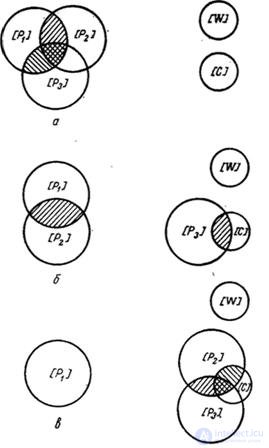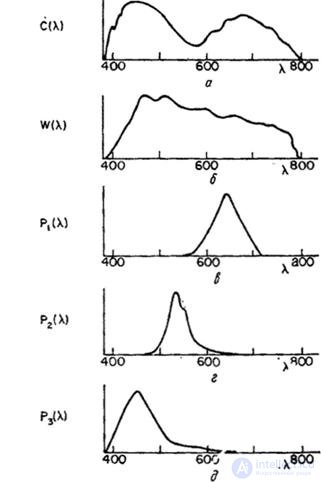Lecture
The basis of the three-color theory of color vision is the possibility of representing an arbitrary color by adding the three primary colors in the required proportion. With additive color reproduction, for example, in color television, there are three sources of light — red, green, and blue — that are projected onto one area of the surface, where the specified color is reproduced. With subtractive color reproduction, on which color photography and printing are based, white light acquires the desired color by passing successively through cyan, magenta, and yellow filters.
Experiments with additive color equalization are carried out according to the scheme shown in Fig. 3.3.1. A spot of light is projected onto the surface of an ideal diffuse reflector.  (Fig. 3.3.1, a) with an arbitrary spectral density, shown in Fig. 3.3.2, a. A white reference spot is projected onto the same surface.
(Fig. 3.3.1, a) with an arbitrary spectral density, shown in Fig. 3.3.2, a. A white reference spot is projected onto the same surface.  with the spectral density shown in fig. 3.3.2, b, as well as overlapping spots
with the spectral density shown in fig. 3.3.2, b, as well as overlapping spots  ,
,  ,
,  three primary colors with spectral densities shown in fig. 3.3.2, c, d, d
three primary colors with spectral densities shown in fig. 3.3.2, c, d, d

Fig. 3.3.1. Color matching: a - three primary colors; b - two primary colors; in - one primary color.
First, the intensities of the three primary colors are set so that the total part of the spots has the same lightness, color tone and saturation as the reference white color.  . Intensity
. Intensity  ,
,  ,
,  measured in any physical units, for example, in watts. They are equalizing values for the reference white color. Then the intensities of the primary colors are set so as to achieve the equalization of the given color.
measured in any physical units, for example, in watts. They are equalizing values for the reference white color. Then the intensities of the primary colors are set so as to achieve the equalization of the given color.  . If equalization is achieved, record the intensities.
. If equalization is achieved, record the intensities.  ,
,  ,
,  and calculate the normalized values
and calculate the normalized values

 (3.3.1)
(3.3.1)
which are called color coordinates.
If this color cannot be equalized, from the circuit of fig. 3.3.1, and pass to the scheme fig. 3.3.1, b. One of the primary colors, for example  It is superimposed on a spot of a given color, and the intensities of the three primary colors are selected until an equalization of the common part of the spots is achieved.
It is superimposed on a spot of a given color, and the intensities of the three primary colors are selected until an equalization of the common part of the spots is achieved.  and
and  and common parts of the stains
and common parts of the stains  and
and  . If such an adjustment is obtained, then the color coordinates are equal
. If such an adjustment is obtained, then the color coordinates are equal


 (3.3.2)
(3.3.2)

Fig. 3.3.2. The spectral density of the radiation energy: a - arbitrary color; b - reference white color: c - red primary color; g - green primary color; d - blue primary color.
In this case, the coordinate  negative. If it is not possible to achieve adjustment with such a scheme, you need to try to equalize the combination
negative. If it is not possible to achieve adjustment with such a scheme, you need to try to equalize the combination  and
and  with combination
with combination  and
and  . If equalization is achieved, the coordinate
. If equalization is achieved, the coordinate  need to take with a minus sign. If this configuration also fails, try to equalize
need to take with a minus sign. If this configuration also fails, try to equalize  and
and  with
with  and
and  . Proper adjustment in this case means that
. Proper adjustment in this case means that  negative.
negative.
Finally, in those rare cases when it is not possible to achieve equalization according to the scheme of fig. 3.3.1, a, not according to the scheme of fig. 3.3.1, b, you need to impose two primary colors on this color  and try to equalize the color of the overall frequency of these three spots with the remaining primary color. If equalization is achieved for the scheme of fig. 3.3.1, c, then the two color coordinates take on negative values:
and try to equalize the color of the overall frequency of these three spots with the remaining primary color. If equalization is achieved for the scheme of fig. 3.3.1, c, then the two color coordinates take on negative values:


 (3.3.3)
(3.3.3)
If the adjustment is not achieved by this scheme, one of the two remaining combinations will lead to success.
The process described above implements the direct method of quantitative description of colors. It has two drawbacks: it is rather cumbersome and the results obtained depend on the individual properties of a single observer. In section 3.4 discusses in detail the standardized method of quantitative measurement of colors.
Comments
To leave a comment
Digital image processing
Terms: Digital image processing